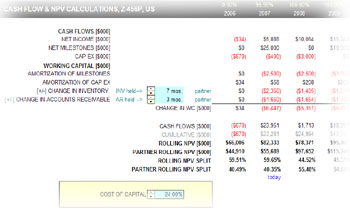|
Case Studies

This cash flow model case study is based on a real world,
but sanitized financial valuation of a patented, early stage
pharmaceutical oncology drug cocktail.
The cash flow model itself is relatively
simple. The innovation comes in the understanding and
modeling of future events in an accurate and user friendly
manner. The results of the cash flow analysis is a
realization of the capitalization requirements of the
venture, the potential profitability of the firm, and
valuation of the company today and in the future. In
addition, we can readily see what the licensing and
partnering effects of a deal might be and what items are
most sensitive to changing the balance of an agreement.
We talk more about deal terms and deal structuring in our
Licensing and
Partnering page.
The basics of the cash flow model require
that we start with our net income, which is derived from the
end of our expense
model. We then add back
amortized and depreciated receipts or payments. The
next step is to rectify all of the
non-cash items such as the amortization and depreciation
values that were used to determine our net income.
We also need to account for other
working capital items such as change in current assets [i.e.
inventory] and current liabilities [i.e. accounts
receivable]. We finally sum the working capital
requirements with the net income and amortized and
depreciated receipts or payments to get the cash flows over
time.
 Once
we establish our cash flows we need to derive a terminal
value to accurately value the product. This is simply
illustrated in a formula in the image on the right where 'CFend'
is the final cash flow of our model, 'g' is the terminal
growth rate, and 'r' is our cost of capital. Of
course, expert opinion has a great deal of impact on the
terminal growth rate and depends on what stage the product
is in. If the model ends while the product is in the
growth stage, the terminal growth rate will probably be a
positive value. Respectively, if the model ends during
product maturity or decline, the growth rate could be flat
to negative. Once
we establish our cash flows we need to derive a terminal
value to accurately value the product. This is simply
illustrated in a formula in the image on the right where 'CFend'
is the final cash flow of our model, 'g' is the terminal
growth rate, and 'r' is our cost of capital. Of
course, expert opinion has a great deal of impact on the
terminal growth rate and depends on what stage the product
is in. If the model ends while the product is in the
growth stage, the terminal growth rate will probably be a
positive value. Respectively, if the model ends during
product maturity or decline, the growth rate could be flat
to negative.
A simple cumulative sum of expected cash
flows will determine the capitalization requirements of the
firm and is an invaluable tool when working on garnering
additional funding.
We can finally calculate our NPVs over time.
This is a good way to illustrate how the value of the firm
varies over time and can help target a time frame where the
value of the product is at a maximum.
|

